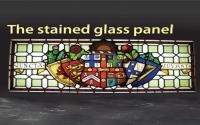HISTORY OF THE STAINED GLASS PANEL
26 March 24
The stained glass panel
In 1950, VW Bro Dr Alexander Hayward Parker, a local medical practitioner, called at the home of one of his patients at Loch Street, Campsie. To his amazement, he discovered that the central panel of the window at the end of the small verandah featured the Coat of Arms of the United Grand Lodge of NSW in stained glass.
This naturally aroused his curiosity and he enquired of the occupants and later the owner of the house how the stained glass panel was installed on the front verandah. He was told the house was built in 1910 by a Mr Abbott for his own use with the timber and material coming from the old Masonic Hall in York Street which was then being demolished.
Mr Abbott built the house and lived in it with his family for some time before moving to Balmain. He was not a mason but his son was only a child when the family lived in Campsie and was not aware that the panel was the Coat of Arms of the UGL.
VW Bro Dr Parker immediately told Grand Lodge of his discovery but was informed by the then Deputy Grand Secretary that he must not interfere as the Coat of Arms was installed in a private dwelling.
This reply did not satisfy VW Bro Dr Parker who had a nagging and impelling urge to secure that stained glass Coat of Arms for Grand Lodge. After a time he felt compelled to call on Mr Abbott to ascertain if it were possible to make some mutually satisfactory arrangements for the panel to be removed from its position in the cottage at Campsie and returned to the Grand Lodge.
Mr Abbott was agreeable to VW Bro Dr Parker’s proposition provided Dr Parker arranged for another window to be installed in its stead, not necessarily a stained glass panel. This was done with the willing aid of Bro Stan Squire, a local glass merchant and W Bro Keith Smith of Lodge Justice No 461, who removed the panel from the window and made a box to house it.
So in 1960, ten years after its discovery, the stained glass panel was returned to Grand Lodge where it is proudly exhibited in the prominent position it now occupies in the entrance to the Museum of Freemasonry.
The stained glass panel is stated to have been made in Belgium from Belgian glass, sometime around 1888/90. It is not known who submitted the design to the manufacturers or who ordered and paid for it, nor is it known why, when the UGL of NSW was so newly and enthusiastically formed, the panel was left behind in the old York Street Masonic Hall, subsequently to be taken to Campsie as part of a second-hand dealer’s sales transaction.
We are fortunate that VW Bro Dr Parker of Lodge University of Sydney No 544, discovered it and by his persistence, secured it for Grand Lodge.
Observers should stand back from the panel and look up to the four rondelles on the arms of the Cross of St George on the escutcheon which from the front appears to be circular. You will notice that the glass of the rondelles are shaped from within to give an iridescent sparkle resembling that of stars and also that the light green muffled background glass becomes aerated or bubbly in appearance.
The observer will notice that the colour of the cross in the shield at the right-hand side of the escutcheon is blue and that it bears five five-pointed stars on the cross. This was the design of the old unofficial badge of the State of NSW which was superseded by the official badge on 15 February 1876. The present design showing a golden lion on a red cross of St George on a white field with a golden five-pointed star on each arm of the cross was designed by James Barnet, the Colonial Architect, and Captain Hixson, RN (Ret), who was the president of the Marine Board.
The size of the stained-glass panel is 510 x 1245mm or 20 x 49 inches.
The Stained glass panel is now located at the entry passageway to the Museum room at the Museum of Freemasonry at the Syndey Masonic Centre.
If your Lodge would like to book a private tour of the Museum please contact RW Bro Craven at [email protected]
For the general public, we invite you to book a guided tour, they are conducted at 11 am on Tuesdays, Wednesdays, and Thursdays by prebooked appointment. The cost is $20pp and each person receives a small souvenir of their visit. Visitors will see areas not available on general visits. Plus, you hear unique insights and information from the tour guide, Please see https://mof.org.au/ for more information and bookings.
General entry is free and available Monday to Friday 8.30 am to 4.30 pm.
This article originally appeared in the Freemason Page 10, February 2009.


